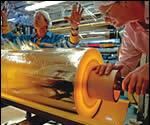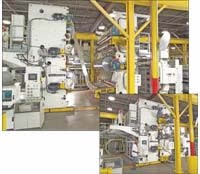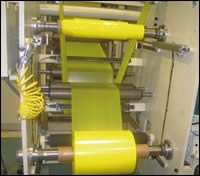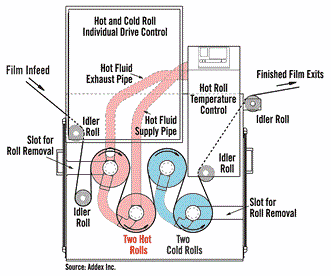MDO Films: Lots of Promise, Big Challenges
Machine-direction orientation is still discovering new market opportunities. But the technical difficulties are so great that some big projects never came of age. New equipment could make it easier.
Stretching film in the machine direction magnifies its properties—not just a little, but a lot. MD orientation of blown and cast films, whether off-line or in-line with extrusion, enhances barrier, stiffness, flatness, tensile strength, and porosity. It reduces stretchiness and, of course, makes two or three times more product with the same amount of plastic. Because MDO films are also very flat, they run many times faster in downstream converting operations, adding still more value.
Given all these advantages, why aren't there more MDO film products in the market? Because most MDO films, beyond a few relatively simple products like monolayer stretch film, are very, very difficult to get right. For example, MDO can enhance nylon and EVOH barrier properties, but it also makes them brittle. "If you know how much to preheat, how much to stretch, and where to anneal," you can make a successful product, cautions Kevin Henderson, technical marketing manager at Avery Dennison's Engineered Films Div., Concord, Ohio.
Machine builders report a growing volume of processors asking about MDO equipment, but these processors often don't have any idea of what they need or of how difficult a challenge awaits them. Over the years, at least three major packaging companies invested heavily to develop MDO films and installed multiple production lines, only to abandon them with little to show for their effort and expense.
Most MD orienters are used as the first stage in biaxial film and sheet production. But stand-alone MDO units have generated innovative film products since the 1960s, such as PET strapping, PVC food wrap, foamed PP ribbon, and fibrous HDPE ribbon for weaving sacks. MDO film hit the big time in the 1990s with breathable hygienic films for diaper liners, self-adhesive labels, and synthetic paper. These products were made on wide lines with high outputs. Marshall & Williams (one of the major equipment providers) has sold five of its largest MDO units—4 meters wide—for making hygiene films. Davis-Standard has also built its largest units—2 meters wide—for hygiene films. SML in Austria has built MDO lines for hygiene films up to 3.2 meters wide.
Processors typically develop new MDO film products on full-scale production equipment or on home-made, half-sized R&D lines. Either way, the machine design is usually specific to one product and offers little flexibility. Although lab-scale MDO lines are available from M&W and Dr. Collin GmbH in Germany, they are of limited use to processors because they are too narrow to make samples that converters could test on full-size converting machines. Some resin companies, however, have found lab MDO lines useful.
There are also monoaxial films that are stretched only in the transverse direction to make products like shrink labels. But TDO systems can be even more limited in product flexibility than MDO units.
In the past year or so, there has been a small but significant change in the flexibility of MDO equipment. Processors have bought full-sized production orienters with extra features intended purely for R&D. These orienters not only control the temperature and speed of every roller individually, they offer multiple web paths and multiple draw options. This uncommon level of flexibility should make new film product development easier.
Too many choices?
MDO equipment can have an almost unlimited number of variables: the number and temperature of preheat rollers (two to a dozen or more); the type of roll heating (water, oil, or electric); the size of the gap between S-wrapped draw rollers (up to 2 in.); how many times film is drawn (one to three or more); temperature and dwell time for annealing or heat-setting; and the temperature and number of cooling rolls.
The number of preheat rollers is determined not by the amount of stretch desired, but by the resin and intended throughput rate—more rollers, more throughput. Standard preheat-roll diameters are 12, 18, or 24 in., though they can get as big as 30 in. Film can be drawn once or multiple times, punctuated by intermediate heating or cooling to obtain different effects. Drawing can be done hot or cold.
Drawing is relatively straightforward. A fast-draw roller turns faster than a slow-draw roller by a specified amount, stretching the film in the gap between them. "You just have to find the right temperature and draw ratio, and that can be a pain," says Eric Hatfield, managing director of operations at FlexTech Packaging Inc. in Cincinnati, which specializes in MDO films.
Short-gap stretching is typically less than 2.5 mm, long-gap stretching is 5 to 50 mm or more. There is even so-called "zero-gap" stretching or "compression-roll drawing." The shorter the gap, the less film neck-in occurs. Neck-in typically reduces film width by 5% to 20%. Neck-in also reduces the breathability that is critical to hygiene films. SML patented the use of rubber drawing rolls that reduce neck-in.
Annealing is the hardest part, says Flex Tech's Hatfield, because film can be made to stretch or shrink by speeding up or slowing down the annealing rolls. Any change in speed or temperature changes the resulting film properties.
MDO's ability to downgauge film and improve its properties at the same time is a compelling combination. Downgauging is a large part of why processors try so hard to make MDO work. Honeywell Specialty Materials took several years to develop an MDO version of its Aclar monolayer PCTFE fluoropolymer film to replace metal foil with a clear moisture barrier. Honeywell found that monoaxially stretching Aclar film doubled its moisture barrier, so 25-micron MDO Aclar has the same moisture barrier as 50-micron unoriented Aclar.
MDO Aclar is close to its first commercial use in a pharmaceutical package. The film is made in Pottsville, Pa., on three high-temperature orienters from Marshall & Williams with oil-heated rollers that can go up to 600 F.
Stretching blown film
In the past few years, the pace of new MDO film developments has picked up, especially those based on blown film. Machine builders have respon ded to that interest with new hardware designs.
Bruckner Maschinenbau GmbH in Germany, inventor of some of the earliest biaxial stretching technology, has now taken an interest in MDO. Last year, Bruckner set up a new group to design and build monoaxial stretching lines for barrier and shrink films. A company spokesman notes that these films "are gaining more and more significance" in the market.
Several builders of blown film machinery have also entered the MDO market with "starter units." Addex Inc., for example, is building its first MDO unit now. Dubbed "MDO Light," it will stretch coex blown film very slightly—around 3%—to flatten its inherent bagginess. MDO Light is only a four-roll system with two 20-in. diam. heating rolls and two 20-in. cooling rolls, all individually driven. Tension control on the four rollers is accomplished not with load cells, but with fiber-optic tracking of roll diameter, rpm, and torque.
The first of these units ships this month to Polyexe Corp. in Brentwood, N.H., to flatten an unslit tube of three-layer coex PP film with a layflat of 40 in. After flattening, the film runs many times faster through a silicone-coating process. Silicone-coated release films are a growing market for protective backings for labels, adhesive bandages, and diaper tabs.
Polyexe plans to use its MDO Light line to develop other products with more stretch. "We'll see how much more the machine can do," says Oliver Zoellner, technical director. "We intend to play with it."
Other blown film machine builders have launched their own MDO orienters. Hosokawa Alpine has supplied a dozen MDO units to processors in Europe, South America, and Asia. The first went to a processor in France, where it runs in-line with extrusion after the tube is slit. That system requires two MDO units, one for the top web and one for the bottom. Alpine's later MDO units are used off-line and need only one orienter.
Alpine uses individual servo drives for heating, annealing, and cooling rollers, any of which can be used to stretch the film. They all have individual tension control to take up both the film's expansion during heating and its contraction during cooling, so as to avoid wrinkles and buckling. Individual roll temperatures are needed for coex films, where a seal layer requires lower temperature than other layers.
At last year's K 2004 show in Dusseldorf, Alpine demonstrated off-line MD orienting of film fed from rolls. One film for heavy-duty HDPE sacks was stretched 6:1 (gauge started at 240 microns and finished at 80 microns), while a coex HDPE film for stand-up pouches was stretched 4.5:1.
Battenfeld Gloucester Engineering developed an MDO unit for pre-stretched mono- and multi-layer LLDPE hand-wrapping stretch film. Its first commercial model went to a European processor that orients a collapsed tube with up to 70-in.-wide layflat.
Macro Engineering & Technology also built its first MD orienter for blown pre-stretched (hand-wrapping) stretch film. It orients a collapsed bubble but uses cold drawing, which requires a triple draw and long gap. The collapsed bubble thins after orienting, but is stronger because it has two layers that are left stuck together in the finished product. Cold drawing achieves a special property of "frozen elasticity," Macro explains. It takes very little stretch later to release the pent-up tension. So if a hand-wrapper exerts 5% stretch, the film will shrink back 20%.
Blown film vs. cast
MD orienters are used with cast and blown film, but the properties and product range are very different. M&W says most of its blown film MDO units are used to make diaper film. MDO cast film is splittier in the TD than blown film, since cast film has no initial orientation. But sometimes splittiness in one direction is desirable for films that need a "zip strip." Cast film can also be thicker, and its gauge control is tighter.
Blown film, on the other hand, has an upper limit on starting thickness of about 10 to 15 mils, so after MD orienting, it can be very thin indeed—down to 0.2 mil (5 microns). Blown film also starts with an inherent degree of biaxial orientation, so when strength is needed in an oriented film product, blown film may be the better choice.
FlexTech's blown film No. 2455 is a paper substitute that needs biaxial strength. It flies through printing and converting machinery faster than paper because orienting makes it so flat and stiff. No. 2455 is an asymmetrical five- or seven-layer barrier film of nylon and HDPE. It's used for stand-up pouches of muffin mix.
Trico Industries, North Kingstown, R.I., MD-orients cast film in line with extrusion to make specialty films for graphic arts and packaging, where gauge control is critical. The owners hail originally from M&W but build their own machinery.
Avery Dennison in Painesville, Ohio, makes MDO cast film for self-adhesive labels. Monoaxial stiffness makes the labels dispense easily because they are stiff in one direction to enable easy peeling of the protective backing. At the same time, MDO labels are soft in the transverse direction, so they conform well to rounded shapes like bottles. Avery Dennison has four MDO lines making oriented label films in Painesville and Concord.
Says Kelly Williams in market development for flexible packaging at Equistar, another alternative would be MDO sheet extrusion. "If you MD orient sheet, you can put out a lot more pounds and eliminate the need to laminate films for stiffness," Williams adds. Equistar is working now with an MDO equipment maker that also has sheet extrusion technology.
Adding flexibility
Equipment suppliers are building new MDO units with much more flexibility than in the past. Models designed for product development are being configured with multiple web paths; one-, two-, and three-draw options; and self-threading for safety. M&W is building its most complex orienter ever. It combines three styles of stretching—single draw, dual draw, and "zero draw gap" under compression—as well as individual temperature and speed control on all preheat, annealing, and cooling rollers. The orienter is being built for both production and R&D use.
The Zero Gap feature on this machine is a new technology licensed from ITW Signode and introduced last year by M&W. Zero Gap stretching takes place under compression between two counter-rotating draw rolls. It results in less neck-in and some biaxial orientation, M&W says.
Vertical orienters are also being built with new features for added flexibility. Two years ago, Black Clawson built its first vertical MD orienter (with a 9-ft tower) and has delivered three so far. Their vertical format is self-threading and more accessible to operators. M&W built its first vertical MD orienter in 1995 and says about 20% of its MDO units now are vertical. Battenfeld Gloucester's MDO unit is also a vertical self-threading design.
Material matters
The draw ratio of MDO film is limited by the polymer: roughly 2:1 for polystyrene, 4:1 to 5:1 for LLDPE, 5:1 for nylon, 6:1 to 7:1 for polypropylene, and 8:1 to 12:1 for HDPE. (HDPE homopolymer can achieve 10 times the stiffness of BOPP.) PP stretch can be extended to 8:1 by using copolymers or blending in some metallocene PE. LDPE isn't often MD oriented because its broad molecular-weight distribution gives it too little tensile strength.
Resin suppliers are becoming more interested in MDO, which achieves properties that biaxial orienting can't match. MDO can improve EVOH barrier properties, whereas biaxial orienting destroys them. MDO HDPE has great deadfold properties, which disappear if the film is biaxially oriented. Equistar Chemicals just bought a lab MDO machine from Dr. Collin and has created a computer model of how MDO enhances films' physical properties. Equistar is using this software to develop new bimodal HDPEs for MDO applications.
Bimodal HMW-HDPE allows a wider range of drawing conditions and higher draw ratios, Equistar says, such as 12:1 or 13:1 draw instead of the usual 10:1. At such extreme draw ratios, structural changes occur in the polymer, enhancing film properties, says Ryan Breese, product development engineer.
MD orienting can open pores that impart breathability to products like hygienic liners for incontinence pads. Such films are filled with calcium carbonate and other minerals. After MD orienting, the film is "shocked" with a chill roll, and then MD oriented again to a much greater extent to open up porosity by pulling the polymer away from the filler particles.
A similar porosity effect occurs when stretching film that contains hard spherulites or "beta-formation crystals" that form during annealing. The crystals can be controlled to open pores of a particular size when the film is stretched. Depending on the crystal size, stretching leaves film that is clear, hazy, white, or pearlescent. Avery Dennison uses the smallest crystals to create clarity in its latest MDO label film, a coex PP grade called GCX.
Related Content
Fully Automated Extrusion Process Enables Use of Composites for Manufacturing Pressure Tanks
Amtrol was looking for a more cost-effective means to produce thin-wall liners for a new line of pressure tanks. With the help of a team of suppliers, they built one of the world’s most sophisticated extrusion lines.
Read MoreExtruder Alignment: Important, but Only Half the Equation
The other half? Aligning and supporting downstream equipment. Here are best practices.
Read MoreCooling the Feed Throat and Screw: How Much Water Do You Need?
It’s one of the biggest quandaries in extrusion, as there is little or nothing published to give operators some guidance. So let’s try to shed some light on this trial-and-error process.
Read MoreAvoid Four Common Traps In Granulation
Today, more than ever, granulation is an important step in the total production process. Our expert explains a few of the many common traps to avoid when thinking about granulators
Read MoreRead Next
How Polymer Melts in Single-Screw Extruders
Understanding how polymer melts in a single-screw extruder could help you optimize your screw design to eliminate defect-causing solid polymer fragments.
Read MoreWhy (and What) You Need to Dry
Other than polyolefins, almost every other polymer exhibits some level of polarity and therefore can absorb a certain amount of moisture from the atmosphere. Here’s a look at some of these materials, and what needs to be done to dry them.
Read MoreTroubleshooting Screw and Barrel Wear in Extrusion
Extruder screws and barrels will wear over time. If you are seeing a reduction in specific rate and higher discharge temperatures, wear is the likely culprit.
Read More.png;maxWidth=970;quality=90)



















.png;maxWidth=300;quality=90)













